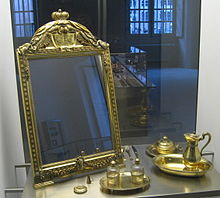Silver-gilt
Silver-gilt or gilded/gilt silver, sometimes known in American English by the French term vermeil, is
Apart from the raw materials being much less expensive to acquire than solid gold of any
Techniques

Silver-gilt objects have been made since ancient times across
Vermeil

Vermeil (/ˈvɜːrmɪl/ or /vərˈmeɪ/; French: [vɛʁˈmɛj]) is an alternative for the usual term silver-gilt. It is a French word which came into use in the English language, mostly in America, in the 19th century, and is rare in British English.[4][5][6] "Vermeil" can also refer to gilt bronze, an even less costly alternative construction material than silver.[7]
The US Code of Federal Regulations 16, Part 23.5 defines vermeil thus: "An industry product may be described or marked as 'vermeil' if it consists of a base of sterling silver coated or plated on all significant surfaces with gold or gold alloy of not less than 10-karat fineness, that is of substantial thickness and a minimum thickness throughout equivalent to two and one half (2+1⁄2) microns (or approximately 1⁄10000 of an inch) of fine gold."[8][9]
Considerations in use
Silver objects could be gilded at any point, not just when first made, and items regularly handled, such as
Fully silver-gilt items are visually indistinguishable from gold, and were no doubt often thought to be solid gold. When the
See also
- Category:Silver-gilt objects
- Vermeil Room, in which the White House's extensive collection is displayed
Citations
- ^ German Olympic museum website Archived 2009-05-14 at the Wayback Machine and Beijing 2008 Appendix 8 Archived 2009-06-12 at the Wayback Machine
- ^ "And as when a man overlays silver with gold, a cunning workman whom Hephaestus and Pallas Athena have taught all manner of craft, and full of grace is the work he produces, even so the goddess shed grace upon his head and shoulders" from this translation
- ^ Strong, 11
- ^ Oxford English Dictionary, 2nd. Edition (1989)
- ^ 16 CFR § 23.4 - Misuse of the word "vermeil."
- ^ Compare for example the online collection of the Museum of Fine Arts, Boston, which describes over 800 objects as "silver-gilt" against a handful of pieces of jewellery incorporating "vermeil" Accessed July 30, 2009
- ^ Oxford English Dictionary, Second edition, 1989
- ^ US Code of Federal Regulations, 16CFR23.5, Revised January 1, 2009
- ^ "What is Gold Vermeil? And why is it so great?".
- ^ Glanville, 187
- ^ Inventory
- ^ Scott, 249
- ^ British Museum, mentioning two examples.
General and cited references
- Inventory of the goods, jewels, etc., sold by order of the Council of State from the several places and palaces following:--The Tower Jewel-Houses, Somerset House, Whitehall, Greenwich, Wimbledon, Oatlands, Windsor, Hampton Court, Richmond, Sion House, St. James's, and several other places; with the several contracts made by the contractors for sale of the said goods, etc., from the year 1646 to the year 1652. British Library, Harleian Ms. Article
- ISBN 978-0-415-38215-1
- Koopman Rare Art. Gilt-edged Splendour: Masterpieces in Silver Gilt, with photographs by Guy Hills, ISBN 978-1-898565-12-3
- Scott, Sir George Gilbert, Remarks on secular & domestic architecture, present & future, John Murray, 1857. Google books
- Strong, Donald Emrys. Greek and Roman Gold and Silver Plate, Taylor & Francis, 1979, ISBN 978-0-416-72510-0
